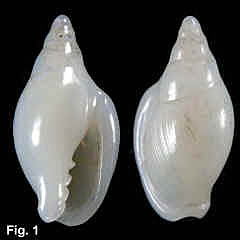|
|
|
|
Austroginella tasmanica (Tenison-Woods, 1876) Diagnosis: Shell medium in size; white to pale yellowish; moderately narrowed anteriorly; spire high with straight sides and slightly rounded whorls; aperture moderately broad; lip smooth, rapidly thickening posteriorly with sharply defined posterior notch, bordered by a parietal nodule; external varix present; siphonal notch present; heavy ventral callus; columella with four strong plaits occupying half or more than half of the aperture. Size: Adults 7-10 mm in length. Distribution: Australian
Museum Collection: Port Stephens, NSW, to eastern Comparison: This
species is the same size and lives in the same habitat as A. johnstoni, but is separated by its narrower shape and taller,
straight-sided spire. The ventral callus is generally thinner than in A.
johnstoni, and there is no nodule or fold on the outside of the body
whorl just before the varix. Remarks: Burn (1958) reported this species living at extreme low tide in sand at Wilsons Promontory, Victoria, and gave a drawing of the animal. Fig. 1: Off Sow and Pigs Reef, Sydney Harbour (C.317944). This specimen is from the lot illustrated by Laseron (1948, fig. 26). |
